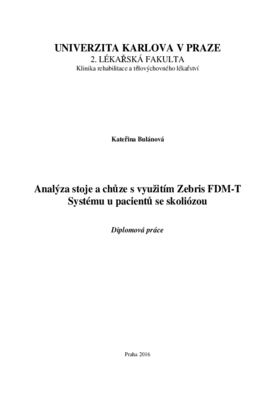Analýza stoje a chůze s využitím ZEBRIS FDM-T systému u pacientů se skoliózou
Stance and gait analysis using ZEBRIS FDM-T System in patients with scoliosis
diploma thesis (DEFENDED)

View/
Permanent link
http://hdl.handle.net/20.500.11956/76238Identifiers
Study Information System: 174992
CU Caralogue: 990020974400106986
Collections
- Kvalifikační práce [1914]
Author
Advisor
Referee
Opálková, Michaela
Faculty / Institute
Second Faculty of Medicine
Discipline
Physiotherapy
Department
Department of Rehabilitation and Sports Medicine
Date of defense
30. 5. 2016
Publisher
Univerzita Karlova, 2. lékařská fakultaLanguage
Czech
Grade
Very good
Keywords (Czech)
Idiopatická skolióza, dynamická plantografie, Zebris FDM-T System, stereotyp stoje, stereotyp chůze, zatížení končetin, délka krokuKeywords (English)
Idiopathic scoliosis, dynamic plantography, Zebris FDM-T System, stance stereotype, gait stereotype, feet load, step lengthDiplomová práce se zabývá problematikou stoje a chůze u pacientů se skoliózou. V teoretické části práce jsou shrnuty současné poznatky o skolióze, její rozdělení, etiologie, patogeneze a rizikové faktory progrese křivky. Dále jsou zde rozebrány nejčastější změny stereotypu stoje a chůze u pacientů se skoliózou a jejich příčiny. Cílem praktické části bylo zjistit rozdíl mezi jednotlivými parametry chůze u experimentální skupiny pacientů se skoliózou a kontrolní skupiny zdravých jedinců. Vyšetření bylo provedeno metodou dynamické plantografie s využitím přístroje Zebris FDM-T System. Pro výzkum bylo vybráno 19 probandů se skoliózou ve věku 8-19 let a 19 ortopedicky zdravých probandů odpovídajícího věkového rozložení jako kontrolní skupina. Výsledky neprokázaly žádný statisticky signifikantní rozdíl na hladině významnosti p=0,05. Přesto byly mezi oběma skupinami zřetelné rozdíly, které vypovídaly o větších asymetriích ve stereotypu stoje a chůze u skupiny pacientů se skoliózou. Vzhledem k tomu, že ani v odborné literatuře nepanují shodné názory na tuto problematiku, bude pro exaktní zhodnocení vlivu skoliózy na stereotyp stoje a chůze pravděpodobně třeba dalších výzkumů.
The thesis deals with the issue of walking and standing in patients with a scoliosis. The theoretical part of this thesis summarizes current knowledge of scoliosis, its classification, etiology, pathogenesis and risk factors of the curve progression. Then the most often changes of the stand and gait stereotype and their main causes are discussed. Goal of the practical part was to identify the difference between particular parameters of gait in an experimental group of patients with scoliosis and a control group of healthy individuals. The examination was performed via the dynamic plantography method using the Zebris FDM-T System. 19 probands with scoliosis aged 8 - 19 and a control group of 19 orthopedically healthy patients in a corresponding age distribution have been selected for the study. The results did not provide any statistically significant difference on a significance level p=0,05. However, there were clear differences between the groups referring to bigger asymmetries in stance and gait stereotype in the scoliosis patients group. Since even in a scientific literature there is a difference in opinion on this issue, more research might be necessary for the exact evaluation of the influence of scoliosis on the stance and gait stereotype.
